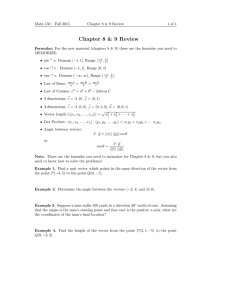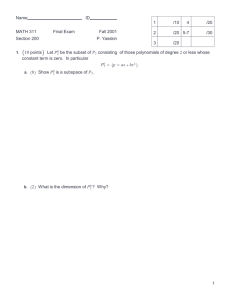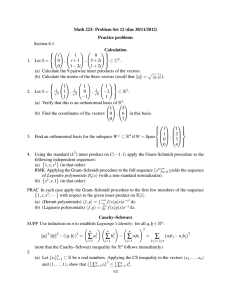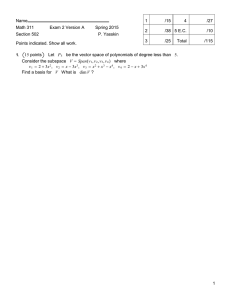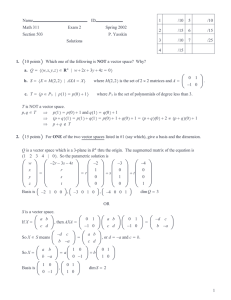Name ID 1 /10
advertisement
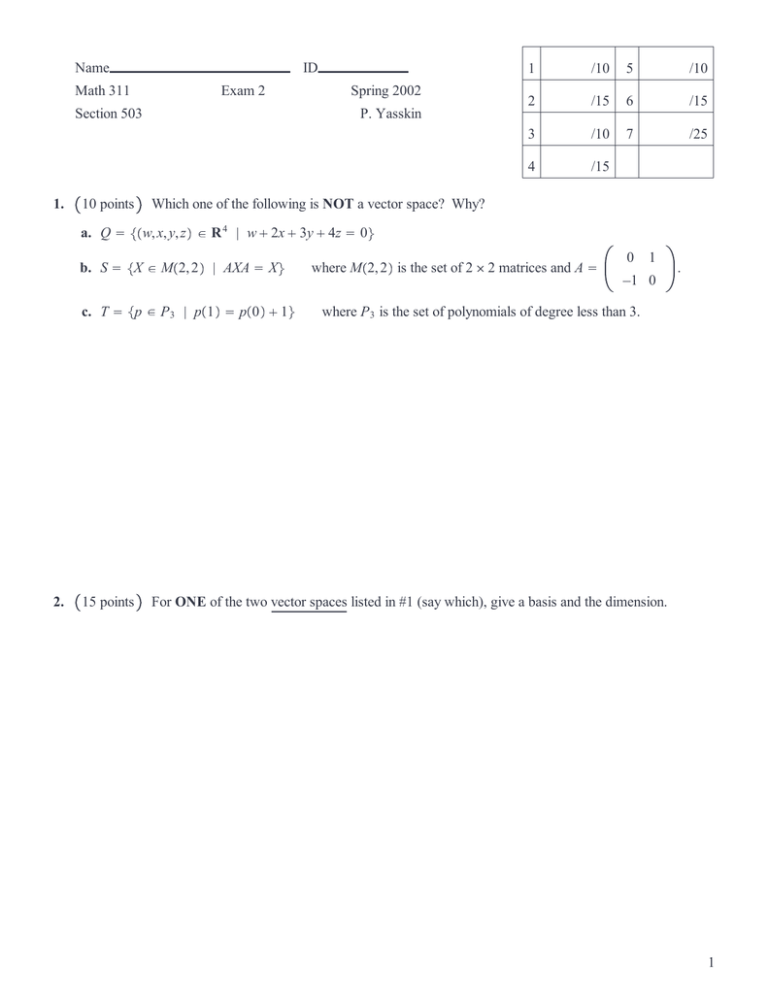
Name Math 311 ID Exam 2 Section 503 1. 10 points Spring 2002 P. Yasskin 1 /10 5 /10 2 /15 6 /15 3 /10 7 /25 4 /15 Which one of the following is NOT a vector space? Why? a. Q = w, x, y, z ∈ R 4 ∣ w + 2x + 3y + 4z = 0 b. S = X ∈ M2, 2 ∣ AXA = X c. T = p ∈ P 3 ∣ p1 = p0 + 1 2. 15 points where M2, 2 is the set of 2 × 2 matrices and A = 0 1 −1 0 . where P 3 is the set of polynomials of degree less than 3. For ONE of the two vector spaces listed in #1 (say which), give a basis and the dimension. 1 3. 10 points Which one of the following is NOT a linear function? Why? a. I : C0, 2π R 2π where C0, 2π is the set of continuous real valued functions on the interval 0, 2π and If = ∫ x + fx dx. 0 b. Z : M2, 2 M2, 2 c. E : P 3 P 3 4. given by ZX = BXB where B = given by Epx = x 1 1 0 0 . dpx − px . dx 15 points For ONE of the two linear functions listed in #3 (say which), find the kernel and the image (as the span of some vectors) and determine if the function is onto and/or one-to-one. 2 5. 10 points Let P 3 be the vector space of polynomials of degree less than 3. Which one of the following is NOT HINT: Let p = a + bx + cx 2 and find which is not positive definite. an inner product on P 3 ? Why? 1 a. ⟨p, q ⟩ 1 = ∫ x px qx dx 0 b. ⟨p, q ⟩ 2 = p0 q0 + p1 q1 c. ⟨p, q ⟩ 3 = p−1 q−1 + p0 q0 + p1 q1 6. 15 points For ONE of the two inner products listed in #5 (say which), find the angle between the polynomials rx = 4x and sx = 6x 2 3 7. 25 points Consider the vector space V = Spansin 2 θ, cos 2 θ, sin θ cos θ a. 3 Show e 1 = sin 2 θ, e 2 = cos 2 θ, e 3 = sin θ cos θ is a basis for V. b. 7 Another basis is f 1 = 1, f 2 = sin 2θ, f 3 = cos 2θ. Find the change of basis matrices from the e-basis to the f-basis and vice versa. Be sure to say which is which. 4 (7 continued) c. 4 Consider the derivative operator D : V V given by Dg = Find the matrix of D relative to the e-basis. dg . dθ d. 6 Find the matrix of D relative to the f-basis in TWO ways. i. by using the matrix of D relative to the e-basis: ii. by differentiating basis vectors: 5 (7 continued) e. 5 Consider the function gθ = 5 sin 2θ + 3 cos 2θ. Compute Dg in TWO ways: i. by differentiating: ii. by using the matrix of D relative to the f-basis: 6




